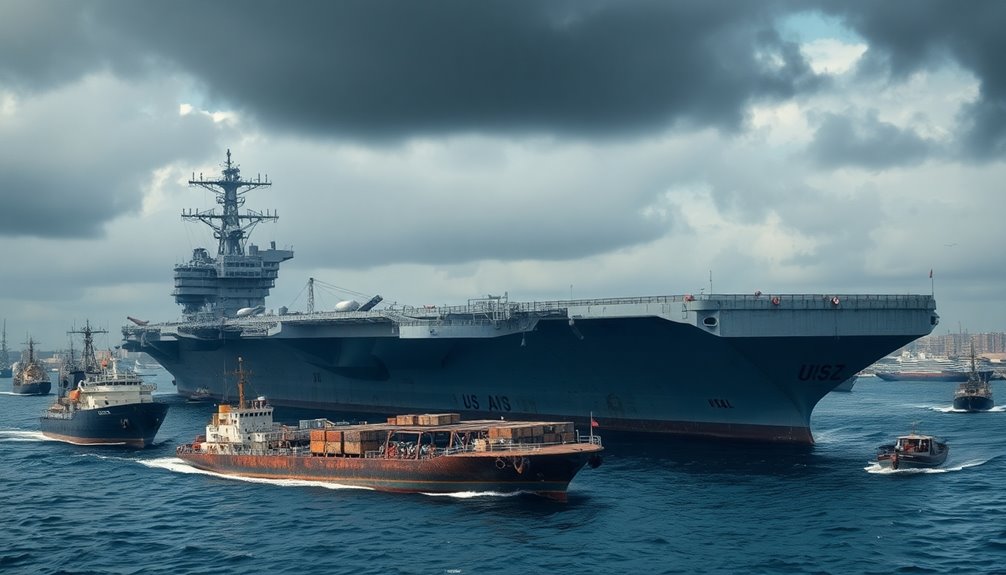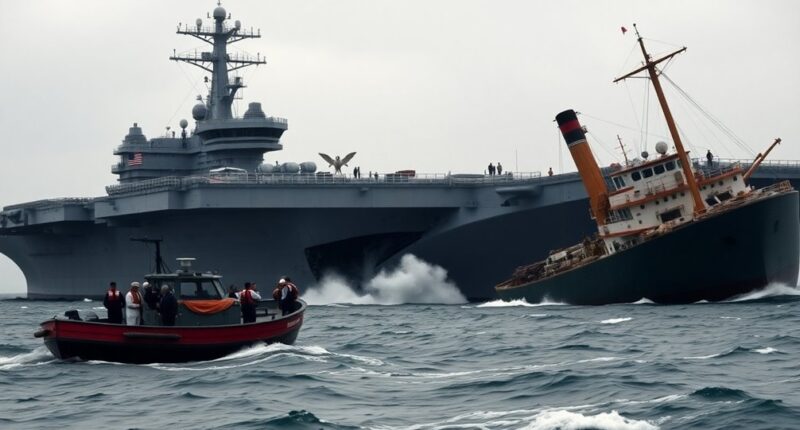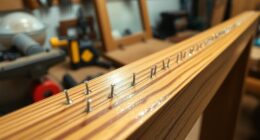The USS Harry S. Truman, a US Navy aircraft carrier, collided with the Panamanian-flagged merchant vessel Besiktas-M near the Suez Canal late Wednesday night. The incident occurred while both ships navigated in busy waters filled with around 100 vessels. Fortunately, there were no injuries reported, and Truman's nuclear systems remained secure despite some damage to Besiktas-M. Such collisions highlight the risks in crowded maritime areas. Discover more about the investigation and implications of this incident.
Key Takeaways
- The collision occurred late Wednesday night near Egypt's Port Said between USS Harry S. Truman and merchant vessel Besiktas-M.
- USS Harry S. Truman is a 1,100-foot-long Nimitz-class aircraft carrier making a port call after combat operations.
- The Besiktas-M, a 617-foot bulk carrier, was exiting the Suez Canal and heading towards Romania during the incident.
- No injuries were reported, and the nuclear propulsion systems of the Truman remained unaffected by the collision.
- An investigation is underway by the US Navy to determine the cause and ensure future maritime safety protocols.

Late Wednesday night, as maritime traffic surged near Egypt's Port Said, the USS Harry S. Truman collided with the Panamanian-flagged merchant vessel, Besiktas-M. The incident occurred around 11:46 p.m. local time, while the area was bustling with around 100 ships. Although both vessels required about one nautical mile to stop, the specifics of the collision remain unclear and are now under thorough investigation.
The USS Harry S. Truman, an imposing 1,100-foot-long Nimitz-class aircraft carrier, had just wrapped up combat operations in the Central Command region before making a port call at Naval Support Activity Souda Bay in Greece. Meanwhile, the Besiktas-M, a 617-foot bulk carrier, was exiting the Suez Canal and heading towards Romania. The Truman recently completed combat operations before the incident, highlighting the carrier's operational readiness in a busy maritime environment.
Fortunately, no injuries were reported on either ship, though the Besiktas-M did sustain some damage. The Truman's nuclear propulsion systems remained unaffected, ensuring the safety of the carrier.
This incident highlights the challenges of maneuvering in crowded maritime environments, especially in strategically important areas like the Suez Canal, where approximately 12% to 15% of global trade passes daily. The risk of collisions increases significantly in such busy waters, which can complicate operations for large vessels like the Truman and the Besiktas-M.
The US Navy is conducting an investigation to ascertain the cause of the collision. While accidents involving US aircraft carriers and commercial vessels are rare, the last recorded instance was in 2004.
The Navy has faced scrutiny in the past, particularly following significant incidents involving destroyers in 2017 that resulted in casualties. This collision serves as a reminder of the inherent risks in global maritime operations, especially in areas where shipping traffic is dense.
As the investigation unfolds, the safety measures already in place, including the stability of the Truman's nuclear systems, should reassure those monitoring the situation.
Frequently Asked Questions
What Safety Measures Are in Place for Naval Vessels Near the Suez Canal?
When navigating near the Suez Canal, you must adhere to strict safety measures.
Ensure your vessel complies with international collision regulations and maintain visible load lines. You'll also need to take a pilot for guidance.
Keep a safe distance from other vessels and avoid prohibited activities like anchoring.
If an emergency arises, be ready to signal using the designated whistle blasts, and maintain radio communication for instructions.
Safety's paramount in these busy waters.
How Often Do Collisions Occur in the Suez Canal Region?
Collisions occur in the Suez Canal region, but they're not as frequent as you might think.
With nearly 19,000 ships passing through annually, the risk rises amidst busy maritime traffic.
While grounding incidents dominate the statistics, collisions still pose a threat, especially to larger vessels.
You can't ignore the challenges of navigation and communication in such crowded waters.
Each incident emphasizes the need for improved safety measures and pilot training to prevent future occurrences.
What Is the Size Difference Between a US Navy Carrier and Typical Merchant Ships?
When comparing a US Navy carrier to a typical merchant ship, you'll notice significant size differences.
A Nimitz-class carrier spans about 1,092 feet long and displaces over 100,000 tons, while a bulk carrier like the Besiktas-M is roughly 656 feet long.
The carrier's beam is also wider, at 252 feet.
This size and weight give carriers a distinct advantage in speed and operational capabilities, making them formidable assets in naval operations.
How Does the Suez Canal's Traffic Management Work?
The Suez Canal's traffic management operates through a convoy system, organizing ships into three daily groups.
You'll find the Vessel Traffic Management System (VTMS) crucial, as it uses radars and cameras to track vessels in real-time.
Mandatory pilotage ensures navigational safety, while communication systems keep you connected.
With strict vessel declaration requirements and ongoing surveillance, the Canal effectively manages the significant global trade traffic that transits through it daily.
What Are the Legal Consequences of a Collision Involving Military Ships?
Imagine a chess game where each piece has its own rules.
In military ship collisions, legal consequences can be just as complex. You'll find that federal courts handle these cases, often under admiralty law. If both vessels share fault, they might split damages.
However, military vessels enjoy certain protections, like sovereign immunity, unless proven negligent. Investigations follow, ensuring accountability and preventing future mishaps, much like reviewing a game strategy after a blunder.
Conclusion
In the stillness of the night, the echoes of metal clash, the cries of startled sailors, and the blaring horns of distress fill the air. You can almost feel the tension, the uncertainty that hangs like fog over the waters. As the sun rises, shadows of the collision linger, reminding us that even giants can stumble, and even the mightiest vessels can falter. The Suez Canal, once a path of smooth sailing, now carries the weight of this unexpected disaster.









